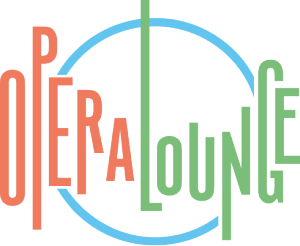“Without question, the most important book ever written in English about opera in performance . . .a cri de coeur, documenting the devastation of a single precinct of Western high culture in modern and postmodern times. . . It is hardly an exaggeration to suggest that the fate of 21st-century opera partly hinges on the fate of the bristling insights delineated and pondered in this singular megabook”. Schreibt Joseph Horowitz im The Wall Street Journal.
Von Zeit zu Zeit gibt es einen Anstoß, ein neues Buch über etwas, das die Wahrnehmung des Gewohnten verändert oder Zweifel am Gewohntebn verstärkt bzw. erklärt – das 827 Seiten starke Kompendium von Conrad L. Osborn Opera as Opera bei Proposito Press ist so eines, das die Augen für den heutigen Opern-Betrieb, seine akuten Defizite, seine Verwurzelung in zeitlich und politisch langen problematischen Entwicklungen sowie seine Unfähigkeit zur Erneuerung herausarbeitet, beleuchtet, erklärt. Die Oper, sagt der Autor, befindet sich in künstlerischen Untiefen, die weit über die generationsweisen Unterbrechungen hinausgehen und durch Opernliebhabern und Machern selber verschuldet sind.
Das Buch gliedert sich in sieben Teile. Vierzehn Essays über die Kunstform Oper, ein Kapitel über die Produktionen und Ausstattungen, eines über den intellektuellen Background, ein sehr langes über die Auffürungen, ein nächstes über Kritiken und einige Updates, schließlich der Epilog/ die Ausschau und ein letztes Die Backstories (eine Chronologie der audiovisuellen Medien, ein bibliographischer Aufsatz sowie Themen und Variationen). Dazu ein sehr hilfreiches Glossar und Namensverzeichnis, alles auf satten 827 Seiten ohne Illustrationen, was sicher die Herstellungskosten in schwindelnde Höhen getrieben hätte.
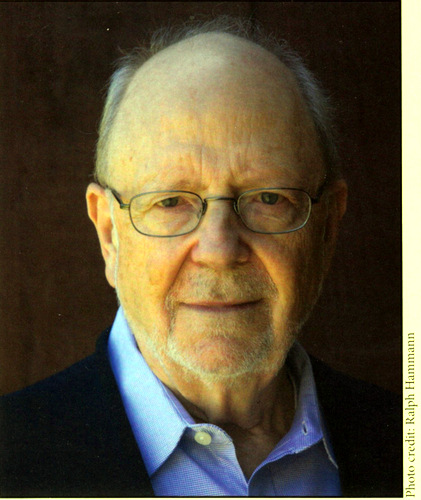
Conrad L. Osborne/ Photo Hammann/ Osborne
Ein Wort zum Autor: Conrad C. Osborn ist in amerikanischen Kritiker- und Opernkreisen kein Unbekannter. Während seiner Karriere als Kritiker von mehr als 60 Jahren hat er Hunderte von Artikeln und Kritiken für das Magazin High Fidelity Musical America, Opera News, The Times und The Financial Times, The Musical Newsletter, Opus, Keynote und viele andere Publikationen geschrieben. Er ist zudem der Autor des Romans O Paradiso und schreibt regelmäßige Beiträge für The Metropolitan Opera Guide to Recorded Opera und Opera on Video. Auch als Schauspieler und Sänger ist er hervorgetreten und hat für lange Jahre Gesang und Interpretation unterrichtet. Osborne saß zudem im Vorstand und in beratenden Positionen mehrerer Kunst-Stiftungen und NGOs. Er lebt und unterrichtet in New York City. Sein zweiwöchiger Blog Osborne on Opera erreicht eine große und ergebene Leserschaft. (Quelle: Klappentext)
Da das Buch in Englisch geschrieben ist und gewisse Kenntnisse der Sprache und auch der Materie voraussetzt, ist es uns eine besondere Freude, von den Kollegen der amerikanischen platform operawire.com (meine morgendliche web-Diät) ein Interview mit Professor Osborn übernehmen zu können, das der Herausgeber und renommierte Musikjournalist David Salazar mit ihm im Dezember 2018 gehalten hat, dies auch in Englisch natürlich. Wir danken für die Großzügigkeit unter Kollegen. G. H.
Why ‘Opera As Opera’ Author Conrad L. Osborne Asserts That Artform Is In Creative Decline by David Salazar “They just don’t sing as well as they used to.” You’ve heard it at some point during your opera-going. Some might dismiss such a statement as Golden Age Fallacy, nostalgic thinking that only emphasizes the positive aspects of the past and holding them up as better than the positives of the modern era.
But Conrad L. Osborne thinks that is very true, not only with singing, but the performance of opera as a whole. Osborne has known opera his whole life. Growing up in Denver in the 1940s, his father, a bass, used to perform at the Denver Civic Operas and would take the five-year-old Osborne to dress rehearsals. But his big fascination with opera often came from the record collection his father kept. “You would fantasize through these records and you imagine what the world must be when you listen to it,” he told OperaWire in a recent interview. He then moved to New York at age nine and took in his first opera experiences at the New York City Opera and Met Opera in 1947; his first City Opera performance was “Carmen,” while at the Met he saw “Il Barbiere di Siviglia.”
He started his career as an actor, then performed a bit as a singer, and started writing criticism in 1959 for Opera News and later for High Fidelity. He would remain a critic for a lengthy period of time, going back and performing intermittently. He also took up teaching, which remains his “day job.” Throughout his life as an opera lover he has felt that the trend toward the artform’s decline is truly real and he believes it so strongly that he spent the better part of the last 18 years writing an 800-plus page book explaining that not only was opera presented in a far superior manner in the past, but that the current trajectory will not lead to the long-term sustainability of the artform.
“Opera as Opera” is an encyclopedic look at every single aspect of the artform and how it has devolved over the last century. He breaks down trends in directing, singing, acting, and even the creation of operas in the 20th century, all of which he feels have contributed to the artform’s decline. He does establish that opera’s challenges in the 21st century are also demographic and economical, but for him the central issue that is causing the increasing marginalization is an artistic one.
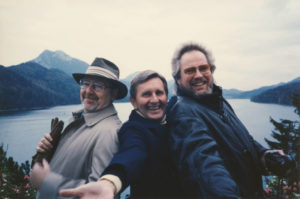
C.L.O. (L.) with bass-baritone Michael Burt (R.) and a friend, southern Austria, l988/ Photo Osborne
Repertory Stagnation: It all starts with the repertoire. Osborne posits that the main staples of the operatic canon start with the major works of Mozart and stretch through until the operas of Richard Strauss; he calls this the Extended 19th Century or “E-19 for short.” Osborne does note that many operas from before and after this period have become part of the repertoire, but in his view, these works are the ones that are part of the “renewable re-affirmability that sustain our operatic institutions.” Moreover, he notes that operas of this period showcase similarity of content in terms of the music, plot and themes they tell, even if there are marked differences of style throughout the period.
In his view, there is a general “flight from E-19” with new operatic creators placing more emphasis on theory and philosophy with regard to how the artform is created, de-emphasizing the narrative roots that were at the core of major staples.
In musical terms, he points to the “atonalists and serialists, creating a whole new language that forbid diatonic melody and sought to express things in different way.” The idea was taken up by the musical intellectuals, pedagogues, and institutions, leading to the idea that “simple, expressive melodies” were outdated for expressive purposes. “And if you did [use melodies], then it had to be so harmonically disguised that the listener couldn’t pick up on it anyway,” he added. “That’s a central problem as far as opera is concerned,” Osborne further opined. “The singing-actor is the center of the operatic experience and characters are expressed through their individual vocal achievements. If you don’t have melody to sing or take advantage of how the voice has been developed over 400 years or so of operatic history, you don’t have much of anything at the center of the form’s expressive possibilities.”
He noted that the result is opera getting built up of other things. “Modernism is built up of materials and structure. The content is not the subject. The subject is the materials.” He referenced the idea that in modern art, the subject of the painting is not what is being depicted, but the paint and canvas itself. In music, the harmonic structures, rhythm, and instrumental timbre are given preponderance over melody in modernism. “That isn’t to say that it isn’t interesting. Some modernist music is very compelling. But it’s not an individual, subjective, emotional expression based on the vocal line, which is, by definition, melodic.”
On a narrative level, Osborne believes “another issue is that everyone is floundering about trying to figure out what there is to sing about. What kind of story makes an opera and how can we tell the story in operatic terms? It isn’t that people aren’t intelligent, or skilled, or creative. But how do you apply them and find solutions to those problems and tell stories in operatic manner.”
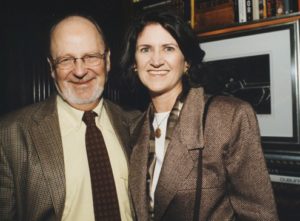
Osborne mit Ehefrau und Schauspielerin Molly bei Ralph Lauren’s, Chicago, 2001/ Photo Osborne
He devotes an entire chapter to exploring the stories and themes explored continuously throughout E-19 operas and why they were so potent for operatic expression; he feels that these principles have been largely abandoned by modern-day librettists. The result is a proliferation of many new works, but few (or none in his estimation) that actually get repeatedly produced and retain strong places in the repertoire. “For a little over 100 years now, we haven’t been adding to the canonical repertory with any degree of success at all,” Osborne noted, emphasizing an overall quality gap that has made these works lack the transcendence of something like the operas of Wagner, Verdi, or Mozart, among others.
That isn’t to say that Osborne hasn’t found anything of quality. He referenced that some composers, such as Thomas Adès, have occasionally excited him. “[Sometimes you run into] compelling passages and scenes, but in terms of adding up to a whole piece that I want to see or hear again or get the score, I don’t ever come away feeling that. Occasionally, I wonder if a different cast or different conductor and director, I wouldn’t mind seeing what might be brought out of it. But that’s as far as I get.”
One particular opera that did pique his interest and makes a prominent appearance in the book is George Benjamin’s “Written on Skin.” Osborne noted that one of the work’s finest features is its narrative, which returns to the medieval roots that most E-19 operas were so successfully based on. “I found the piece quite fascinating and I think it is very compelling and very well-produced and performed,” he noted though he did warn that it is a “a connoisseur’s piece” and worried about whether it would ever hold a place alongside “La Traviata” or “Turandot” in the standard repertory with audiences clamoring at which great opera singer would step up to interpret it at a major theater. “It’s a piece to be appreciated on a more specialized and somewhat more intellectualized level. And that’s fine. It’s a good opera and I think it will have revivals and be done. But it isn’t the kind of opera that will be repeatable or renewable works that will be part of your core repertory.”
Directors As Authors: Because there is repertory stagnation, large opera companies must keep returning to the well of E-19 operas to keep the organizations alive and vital. But in his view, there has been a mistake in how these works have been presented, with the implementation of cultural revisionism and authorial production methods distorting not only the works, but the understanding of what an interpreter is.
The person at the center of this movement? The director. Osborne notes that for him the director’s first and primary job “is to work with the performers to help them find their own creative ways through roles and to bring that out of them on the stage. To find what it is that they individually can bring to a role. And then to coordinate and stage that. And to conform it a very broad outline of the ‘aboutness’ of the work. “Within those boundaries there is an infinite variety of things that you find. Any individual performer or good actor going about looking at these parts will find very different things from another good actor and still be true to the basics of what’s there in the text. And the same with the musical expression of it. Any good singer with a good stylistic feel for a Verdi aria, who looks carefully at what is there in the text and consults his own imagination about what’s going on inside the character, can come up with different interpretations and responses from another artist of that caliber. And any good director will accept that, as long as it doesn’t get out of line with the overall arc that is being done with how the story is being told.”
The “aboutness” is crucial for Osborne as in his estimation, it comes directly from the text and its intentions; not derived from the director’s own imagination of what he or she wishes was in the text. But that is precisely what the director is doing when he or she becomes another author, instead of interpreter, as is the case in the modern opera system. “In my view, it is not the director’s prerogative to believe that he can tell a different story, rewrite the text to mean something that he or she prefers would have been said. If the director doesn’t like what is said or doesn’t think it is relevant, then he should direct something else,” Osborne pointed out. “[In many productions today], the director really is the co-author of the piece. And for me that is an enormous distortion of how interpretation should be done.”
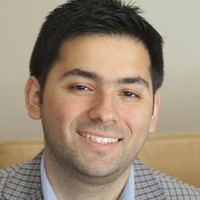
Der Autor, David Salazar, Chefredakteur von operawire.com/ Linkin
This creates issues with how performers can develop and express their characters onstage. Osborne referenced an interview that famed tenor Jonas Kaufmann had with Marie d’Origny in NYBooks.com to set the table. “[Kaufmann] talks about going around from production to production trying to find how to express what it is that you believe about the character, but everything going on around you has nothing to do with that,” Osborne explained. “He even says it would be amusing if it wasn’t sad. He just tries to remember what the last ‘traditional’ impression he had of the role was and tries to go ahead and do that, even though everything around him is something else. And when he tries to bring it up with the director and asks why they have to do something that isn’t indicated and that he as a performer doesn’t believe is going on with the character, he’ll be told not to be so literal about it.” (…)
Soweit unsere Übernahme … die restlichen Teile des Interviews lesen Sie weiter auf der originalen platform operawire.com. Dort spricht Osborne über die verlorenen Stimm-Traditionen und die Hoffnung, die ihm doch noch bleibt: “An effort has to be made from an interpretative point of view to restore the essential integrity of what interpretation is,” he stated. “Any of the canonical operas can still be a thrilling, exciting, transformative experience, if they are performed well enough.” (Conrad L. Osborne: “Opera as Opera – The State of the Art”, Proposito Press, 827 Seiten, Personenverzeichnis, 2018, ISBN 978-0-9994366-0-8/ oder direkt bestellen beim Autor: conrad@conradlosborne.com
